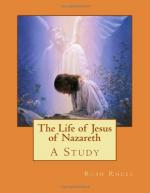14. Two other classes among the people are mentioned in the gospels,—the Herodians and the Samaritans. The Herodians do not appear outside the New Testament, and seem to have been hardly more than a group of men in whom the secular spirit was dominant, who thought it best for their interests and for the people’s to champion the claims of the Herodian family. They were probably more akin to the Pharisees than to the Sadducees, for the latter were hostile to the Herodian claims, from the first; yet in spirit they seem more like to the worldly aristocracy than to the pious scribes. The Samaritans lived in the land, a people despising and despised. Their territory separated Galilee from Judea, and they were a constant source of irritation to the Jews. The hatred was inherited from the days of Ezra, when the zealous Jews refused to allow any intercourse with the inhabitants of Samaria. These Samaritans were spurned as of impure blood and mixed religion (ii. Kings xvii. 24-41). The severe attitude adopted towards them by Ezra and Nehemiah led to the building of a temple on Mount Gerizim, and the establishment of a worship which sought to rival that of Jerusalem in all particulars. Very little is known of the tenets of the Samaritans in the time of Jesus beyond their belief that Gerizim was the place which, according to the law, God chose for his temple, and that a Messiah should come to settle all questions of dispute (John iv. 25).
15. Although the religious life of the Jews centred ideally in the temple, it found its practical expression in the synagogue. This in itself is evidence of the relative influence of priests and scribes. There was no confessed rivalry. The Pharisee was most insistent on the sanctity of the temple and the importance of its ritual. Yet with the growing sense of the religious significance of the individual as distinct from the nation, there arose of necessity a practical need for a system of worship possible for the great majority of the people, who could at best visit Jerusalem but once or twice a year. The synagogue seems to have been a development of the exile, when there was no temple and no sacrifice. It was the characteristic institution of Judaism as a religion of the law, furnishing in every place opportunity for prayer and study. The elders of each community seem ordinarily to have been in control of its synagogue, and to have had authority to exclude from its fellowship persons who had come under the ban. In addition to these officials there was a ruler of the synagogue, who had the direction of all that concerned the worship; a chazzan, or minister, who had the care of the sacred books, administered discipline, and instructed the children in reading the scripture; and two or more receivers of alms. The Sabbath services consisted of prayers, and reading of the scriptures—both law and prophets,—and an address or sermon. It was in the sermon that the people learned to know the “traditions of the elders,” whether as applications of the law to the daily life, or as legendary embellishments of Hebrew history and prophecy. The preacher might be any one whom the ruler of the synagague recognized as worthy to address the congregation.




